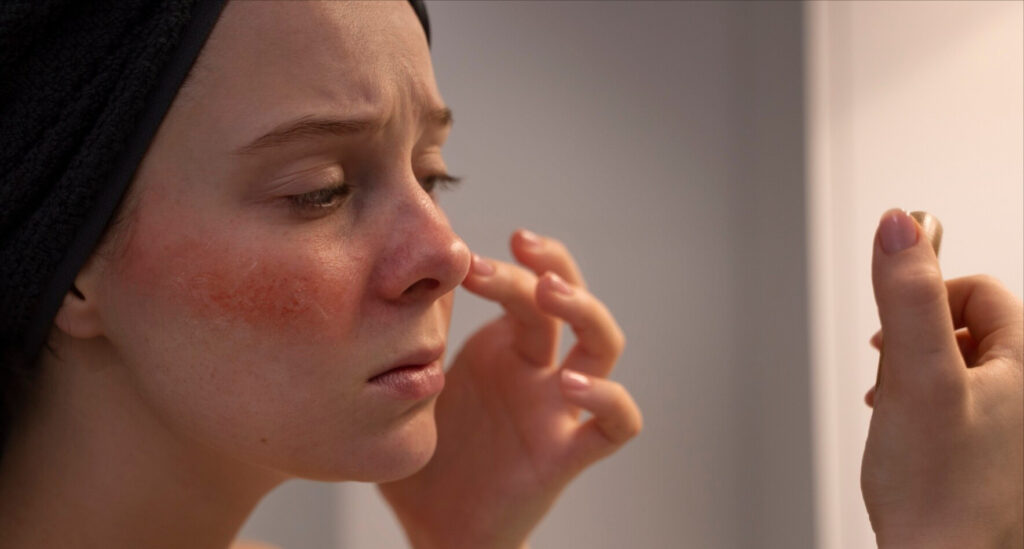
Vitamin K for bruising after fillers can save you from the social embarrassment of post-filler discoloration. With the right aftercare, you can speed up healing and minimize bruising, so you can enjoy your filler results without the wait. After reading this article, you’ll be able to use vitamin K effectively to quickly restore your flawless look.
Mechanism of Bruising after Filler
Bruises are discolorations on the skin caused by the leakage of blood from crushed blood vessels, causing minor bleeding under the skin.
After a dermal filler injection, bruises may occur as a local injection site reaction. In comparison to the surrounding skin, the bruise may be darker, puffy, and painful to touch.
Bruises start as black-and-blue discoloration on the skin and then turn yellow, green, or light brown within five to ten days.
The bruise may last from a few days to two weeks. Some areas are more prone to bruising because of the rich blood flow in them, such as the lips.
Proper post-filler care reduces the duration and severity of the bruising. One of the skincare ingredients used in filler aftercare is vitamin K.
What Is Vitamin K?
Vitamin K is a group of fat-soluble vitamins that are fat-soluble vitamins that are stored in body tissues when consumed in excess. It helps in blood clotting and wound healing and is important in bone and heart health.
Vitamin K1 and K2 are the most common forms of vitamin K. You can get vitamin K1 (phylloquinone) from plants, such as leafy greens, and vitamin K2 (menaquinone) from animal products and fermented foods, and it synthesizes naturally by gut bacteria.
Vitamin K deficiency can lead to bruising, nosebleeds, and hemorrhage. So, keeping a good vitamin K level by eating a balanced diet and applying topical vitamin K cream helps in healing and minimizing bruising after a filler injection or any other procedure.
Does Vitamin K Help with Bruising After Filler?
Vitamin K is an important vitamin for your body’s bone health and blood clotting. As it helps in clotting, it also aids in wound healing and reduces bruising.
It is found in many different creams and is dermatologically recommended after cosmetic injections and surgery. Vitamin K has the ability to remove extravascular blood from the skin, resulting in reducing bruising and swelling, and minimizing the healing time.
Moreover, using topical vitamin K for bruising is beneficial for many other purposes, such as:
- Reducing pigmentation and dark spots.
- Preventing vascular signs of aging.
- Minimizing stretch marks.
- Improving scars.
- Diminishing dark circles under the eyes.
How to Use Vitamin K for Faster Healing After Fillers
Incorporating vitamin K into your post-filler daily skincare routine can significantly improve your bruising and healing after a dermal filler injection.
Apply vitamin K cream to the treated area once or twice daily. Make sure to apply it on clean skin and distribute the cream evenly without vigorous massage to avoid filler migration.
To get the best results, choose a product that combines vitamin K with other soothing and skin-repairing agents, such as arnica montana, vitamin C, vitamin E, bromelain and caffeine.
Consistent application is the key to reducing healing time, minimizing bruising, and optimizing filler results.
Vitamin K cream is safe and suitable for all skin types, including sensitive skin, as it is non-irritating.
When to start applying vitamin K for bruising
Vitamin K cream helps reduce bruising after a filler injection when applied immediarely after receiving the filler treatment, not before it, as it doesn’t prevent bruising but treats it when applied as early as possible after a dermal filler injection.
Common Mistakes to Avoid When Using Vitamin K for Bruising
The key is using the right product in the right way to get maximum results. Improper application and some mistakes can reduce the effectiveness of vitamin K cream for bruising, such as:
- Applying Vitamin K cream too late after a filler injection, just start application as soon as possible.
- Ignoring vitamin K cream application twice daily, be consistent and adhere to your aftercare routine.
- Applying cream with too much massage and pressure may worsen the bruises and cause filler migration; just use gentle circular motions.
- Not choosing the right product, buy a product from a pharmacy or a trusted seller and choose vitamin K creams that contain other ingredients that help with bruising, such as arnica montana.
- Skipping sun protection when going outdoors, sun rays can worsen bruising and slow down healing.
Foods rich in vitamin K
Taking vitamin K internally and applying it externally gives you maximum benefits. Vitamin K is available in many foods, such as:
- Lettuce, spinach, and other leafy greens.
- Broccoli.
- Cauliflower.
- Vegetable oils.
- Blueberries.
- Eggs
- Figs.
Bruising after filler is a common and unwanted side effect; don’t let it annoy you! Start using vitamin K for bruising after fillers and watch your skin recover faster. See the difference and enjoy your filler’s full effect. For the best results, consult your dermatologist to help you choose the right vitamin K cream.
FAQs
Use vitamin K cream for bruising after filler twice daily for effective bruise management and faster healing.
Vitamin K cream is used for bruising, wound healing, dark circles under the eyes, dark spots, improving stretch marks, spider veins, and broken capillaries.
Arnica montana may reduce bruising after filler more effectively than vitamin K. Combining both in one product gives you the best results.
Resources
https://www.sciencedirect.com/science/article/abs/pii/S0190962202000531
https://www.healthline.com/health/4-best-vitamins-for-skin#vitamin-k
https://journals.lww.com/iphr/pages/articleviewer.aspx?year=2014&issue=46040&article=00009&type=Fulltext
https://www.verywellhealth.com/bruises-and-hematomas-4178410#toc-characteristics-of-a-bruise
https://pubmed.ncbi.nlm.nih.gov/20412090/
https://www.healthline.com/health/vitamin-k
https://www.byrdie.com/vitamin-k-for-skin-4801332
